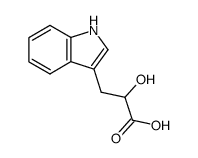DL-INDOLE-3-LACTIC ACID

DL-INDOLE-3-LACTIC ACID structure
|
Common Name | DL-INDOLE-3-LACTIC ACID | ||
|---|---|---|---|---|
| CAS Number | 832-97-3 | Molecular Weight | 205.21000 | |
| Density | 1.423g/cm3 | Boiling Point | 472.6ºC at 760 mmHg | |
| Molecular Formula | C11H11NO3 | Melting Point | 145-146ºC(lit.) | |
| MSDS | Chinese USA | Flash Point | 239.6ºC | |
|
Systematic profiling of indole-3-acetic acid biosynthesis in bacteria using LC-MS/MS.
J. Chromatogr. B. Analyt. Technol. Biomed. Life Sci. 988 , 53-8, (2015) Indole-3-acetic acid (IAA) is produced from tryptophan through five synthesis pathways. A comprehensive method for the quantification of IAA and biosynthesis-related intermediates in a culture medium was developed. Sample preparation was simple with protein p... |
|
|
Characterization of an Antibacterial Compound, 2-Hydroxyl Indole-3-Propanamide, Produced by Lactic Acid Bacteria Isolated from Fermented Batter.
Appl. Biochem. Biotechnol. 177 , 137-47, (2015) Lactic acid bacteria are known to produce numerous antimicrobial compounds that are active against various pathogens. Here, we have purified and characterized a novel low-molecular-weight (LMW) antimicrobial compound produced by Lactobacillus and Pediococcus ... |
|
|
UPLC-MS-based urine metabolomics reveals indole-3-lactic acid and phenyllactic acid as conserved biomarkers for alcohol-induced liver disease in the Ppara-null mouse model.
J. Proteome Res. 10(9) , 4120-33, (2011) Since the development and prognosis of alcohol-induced liver disease (ALD) vary significantly with genetic background, identification of a genetic background-independent noninvasive ALD biomarker would significantly improve screening and diagnosis. This study... |
|
|
Monitoring tryptophan metabolism after exposure to hexaconazole and the enantioselective metabolism of hexaconazole in rat hepatocytes in vitro.
J. Hazard. Mater. 295 , 9-16, (2015) In the present study, the enantioselective metabolism, cytotoxicity of hexaconazole and its influence on tryptophan metabolism in rat hepatocytes in vitro were investigated. Following the exposure of primary rat hepatocytes to rac-hexaconazole, the concentrat... |
|
|
Enantioselective Metabolism and Interference on Tryptophan Metabolism of Myclobutanil in Rat Hepatocytes.
Chirality 27 , 643-9, (2015) Myclobutanil, (RS)-2-(4-chlorophenyl)-2-(1H-1, 2, 4-triazol-1-ylmethyl) hexanenitrile is a widely used triazole fungicide. In this study, enantioselective metabolism and cytotoxicity were investigated in rat hepatocytes by chiral HPLC-MS/MS and the methyl tet... |
|
|
Metabonomics biomarkers for subacute toxicity screening for benzene exposure in mice.
J. Toxicol. Environ. Health A 75(18) , 1163-73, (2012) Benzene is known to produce hematotoxicity in occupational exposure workers. This study examined the utility of metabonomic biomarkers to ascertain subacute toxicity produced by benzene in male C3H/He mice. A 30-d intermittent collection of urine was obtained... |
|
|
Higher plasma 5-hydroxyindoleacetic acid levels are associated with SSRI-induced nausea.
Neuropsychobiology 48(1) , 31-4, (2003) We investigated the association between selective serotonin reuptake inhibitors (SSRIs; paroxetine or fluvoxamine) and nausea with regard to plasma 5-hydroxyindoleacetic acid (p5-HIAA) levels. Forty-eight patients meeting the DSM-IV criteria for major depress... |
|
|
Production of aromatic alpha-hydroxyacids by epimastigotes of Trypanosoma cruzi, and its possible role in NADH reoxidation.
FEMS Microbiol. Lett. 118(1-2) , 89-92, (1994) Epimastigotes of Trypanosoma cruzi in culture produce and excrete into the medium small amounts of phenyllactic acid and p-hydroxyphenyllactic acids, presumably arising from the catabolism of the aromatic amino acids phenylalanine and tyrosine, respectively. ... |
|
|
Determination of urinary 5-hydroxyindole-3-acetic acid using solid-phase extraction and reversed-phase high-performance liquid chromatography with electrochemical detection.
J. Chromatogr. A. 341(1) , 167-71, (1985)
|
|
|
Indole derivatives produced by the fungus Colletotrichum acutatum causing lime anthracnose and postbloom fruit drop of citrus.
FEMS Microbiol. Lett. 226(1) , 23-30, (2003) Postbloom fruit drop (PFD) of citrus and Key lime anthracnose (KLA) are caused by Colletotrichum acutatum. Both fungal isolates can infect flower petals, induce young fruit abscission and result in severe yield loss on many citrus cultivars. Previous studies ... |